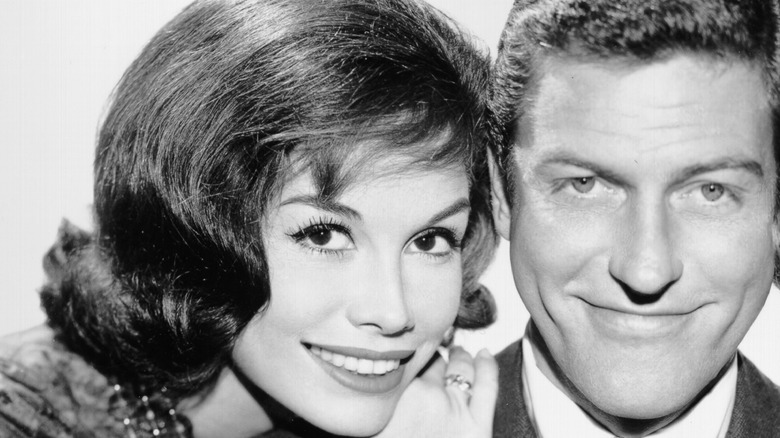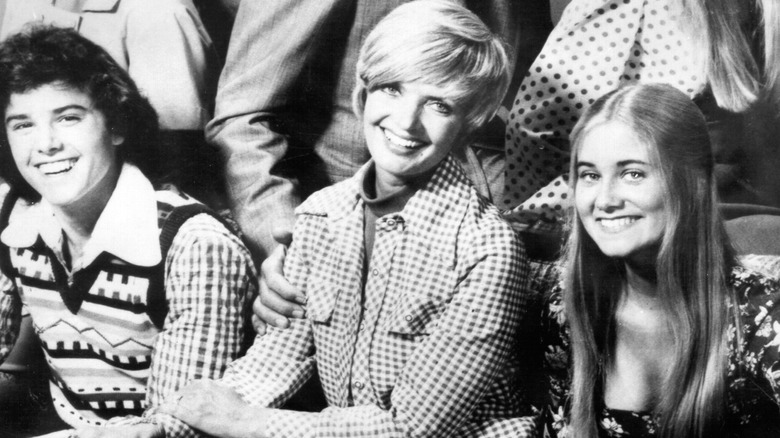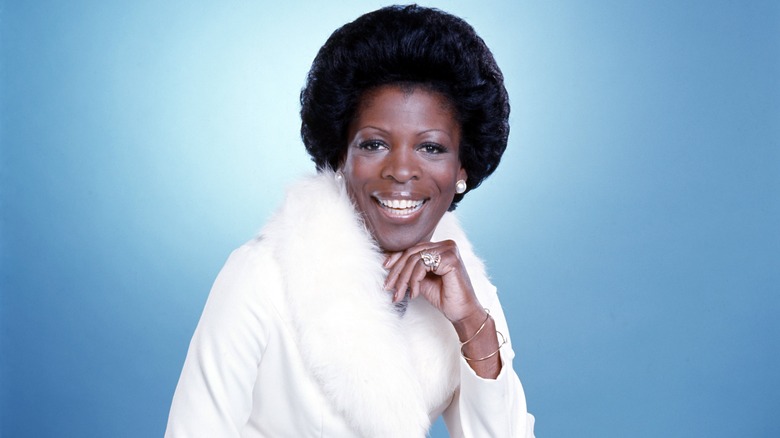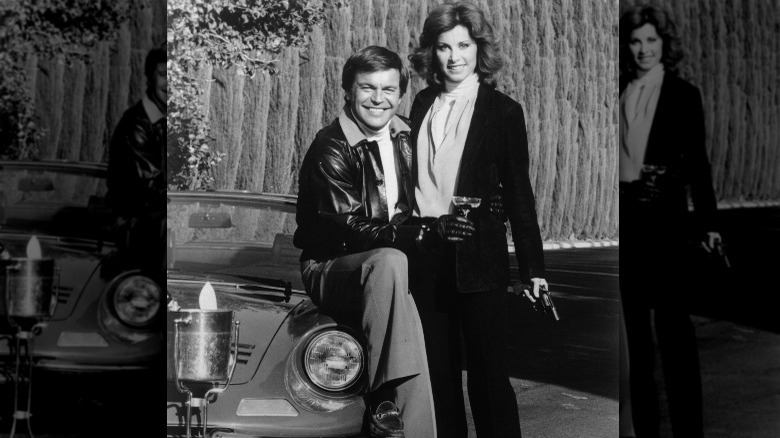'70s TV Characters With The Most Iconic Fashion
As a decade, the 1970s were ripe with groundbreaking fashion, and looks with flare — like bell-bottoms, denim-on-denim, crop tops, and bold prints and colors — have come back into today's style lexicon. The time period was also a significant moment in the growth of the television industry.
According to data collected by the United States Census Bureau, in 1954, 65% of American households surveyed owned a television, and by 1970 that number had jumped to 95%. However, television rarely depicted the more risqué looks of the era, and the networks seemed determined to maintain the facade of homemakers in dresses, done-up hair, and makeup (via NPR).
Though more traditional characters on television rarely broke conventions of modesty and femininity, trailblazer Mary Tyler Moore led the way in asking for more realistic representation of women's lives and style. In the end, the '70s turned out to be a revolutionary era for women in entertainment.
Mary Richards was a new kind of protagonist
When Mary Tyler Moore appeared on "The Dick Van Dyke Show" as Laura Petrie from 1961 to 1966, she dared to do what housewives on television had not — she wore pants. This bold choice would inform her future career in television, particularly her role as Mary Richards on "The Mary Tyler Moore Show." In 1995, Moore shared with NPR that women on TV in the '60s and '70s rarely looked like the people she knew in real life. "I've seen all the other actresses and they're always running the vacuum in these little flowered frocks with high heels on, and I don't do that," she said.
Mary Richards helped to normalize style and freedom in both domestic and professional settings for women on TV. "The Mary Tyler Moore Show" ran from 1970 to 1977 and besides becoming one of the most revered shows in comedy history, its bold premise featured a single woman protagonist, who had a career as a producer for a local news station (per The Hollywood Reporter).
Mary Richards has been recognized as an inspiration by modern designers including Tori Burch and Zac Posen, according to the outlet, and the character's take on '70s pea coats, large collars, and graphic prints left its permanent mark on the world of workplace fashion. Mary Richards became a prime example of an independent working woman, and the character's high-fashion looks further contributed to her inspiring image.
Julia Baker's looks ranged from professional to modelesque
Julia Baker was a nurse and single mother widowed by the Vietnam war on the show "Julia" which ran from 1968 to 1970 (via The Paley Center). The character's style was influenced by the structured look of her nurse's uniform, which she often accessorized with a high-fashion cape coat. Julia's makeup and hair choices — a black cat-eye and a short wavy hairstyle — indicate the show's jumpstart in the late '60s, though the character went on to blend this mod style with newly popular '70s trends, like bold prints.
According to Smithsonian Magazine, memorabilia from "Julia" can be found in the museum, and some of the protagonist's clothing, including a jumpsuit and a dress, has appeared in an exhibit at the National Museum of African American History and Culture.
The character of Julia Baker is not just remembered for her stunning fashion, though. The character also broke ground as the first non-stereotypical depiction of a leading Black character on television, rejecting the limited mold for Black protagonists created in the 1950s. Though "Julia" represented only a small fraction of middle-class Black Americans in the early '70s, the actress who brought Julia to life, Diahann Carroll, acknowledged the impact of her character's representation in an interview with the National Leadership Project. "For the most part, looking back, realizing what we were trying to do at that time, what we were given, the parameters, I feel proud of it. It made a difference. It was the beginning of a new kind of approach."
Carol Brady was the cool mom
For a prime example of TV's leading women stepping up the risks in their fashion choices during the 1970s, viewers would likely also nominate the matriarch of "The Brady Bunch," Carol Brady (via IMDb). Between 1969 and 1974, she went on to wear chunky '70s collars, button-ups, vests with masculine silhouettes, above-the-knee dresses, and iconic pants (via YouTube).
In a 2010 interview with The Television Academy Foundation, actress Florence Henderson revealed her intentions for the character of Carol Brady and made it clear that she was not going to look like every other housewife on TV. For example, she would decline when asked to wear an apron, hoping to depict a more expansive view of motherhood and femininity. "I wanted to wear sexy nightgowns because we were the first couple to sleep in the same bed on television, so I wanted to make her as human as possible," she shared.
Helen Willis served looks on The Jeffersons
Helen Willis was played by the inimitable Roxie Roker, a legendary actress, mother to a certain Lenny Kravitz, and grandmother to Hollywood darling Zoë Kravitz. On "The Jeffersons," which aired from 1975 to 1985, Helen was Louise Jefferson's best friend her husband George's rival (via the Television Academy Foundation). Helen Willis was the couple's neighbor and friend, and she and her husband Tom, who was white, formed an interracial marriage that was rarely depicted on television at the time.
Helen's smart pantsuits, funky blouses, and her character's fluid movement between natural and styled hair were scene-stealers on the show. One of her coats is even available on the memorabilia site The Golden Closet, and her chic silhouettes have cemented the character as a fashion icon to be emulated for decades to come. Combined, her bold wardrobe and personality made her an iconic character to recognize in television history.
Jennifer and Jonathan Hart solved mysteries in style
"Hart to Hart" ran from 1979 to 1984 and focused on a couple who solved mysteries in the world of white-collar crime and murder (via IMDb). Jonathan Hart was the CEO of a Los Angeles corporation, Hart Industries, and Jennifer was a journalist, meaning their detective work was pretty much a passion project, which mirrored their hot and heavy relationship, per Entertainment Weekly. Viewers were wowed by the millionaire couple's opulent lifestyle, complete with expensive cars, a mansion, and plenty of iconic fashion statements. When necessary, the fabulous jet-setting couple also teamed up with their butler, Max.
Both halves of the couple made their mark on fashion history — they donned '70s turtlenecks and aviator jackets and pulled off southern looks on undercover missions. Plus, they were always ready with Jonathan's suave tuxedo and Jennifer's black furs, which were perfect for infiltrating any black-tie event.





